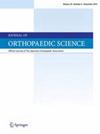成年脊柱畸形患者步态中骨盆前倾的变化对行走能力和身体功能的影响:一项横断面研究。
IF 1.5
4区 医学
Q3 ORTHOPEDICS
引用次数: 0
摘要
背景:使用三维运动分析系统(3DMAS)对步态进行评估后发现,患有成人脊柱畸形(ASD)的老年患者在行走时会出现骨盆内翻。本研究的目的是调查步态时骨盆内翻的变化对 ASD 患者行走能力和身体功能的影响:研究纳入了我院在 2016 年 3 月至 2021 年 12 月期间收治的 54 名年龄在 50 岁或以上的 ASD 患者。采用 6 分钟步行距离(6MWD)评估受试者的步行能力,测量躯干和髋关节伸展力量评估受试者的身体功能。3DMAS 用于测量受试者在步态过程中骨盆前屈的变化。测量骨盆内翻的变化后,计算出研究对象的中位值,并据此将研究对象分为两组(小内翻[S]组和大内翻[L]组)。比较两组的行走能力和身体功能:各组受试者人数均为 27 人。两组间行走能力和身体功能的比较显示,6MWD(S 组,333.6 ± 111.2 米;L 组,238.0 ± 106.3 米)和髋关节伸展力量(S 组,15.8 ± 3.8 kgf;L 组,13.4 ± 4.4 kgf)存在显著差异。各组之间的躯干伸展力量无明显差异(S 组,15.2 ± 4.0 kgf;L 组,12.9 ± 4.8 kgf):本研究结果表明,与行走相关的骨盆内翻较大的 ASD 患者的行走能力和身体功能较低。这些结果表明,评估 ASD 患者的姿势不仅要通过影像学检查结果,还要通过步态等运动评估。本文章由计算机程序翻译,如有差异,请以英文原文为准。
Influence of changes in pelvic anteversion during gait on walking ability and physical function in patients with adult spinal deformity: A cross-sectional study
Backgrounds
Evaluation of gait posture using a three-dimensional motion analysis system (3DMAS) revealed that elderly patients with adult spinal deformity (ASD) experience pelvic anteversion while walking. The purpose of this study was to investigate the influence of changes in pelvic anteversion during gait on walking ability and physical function in patients with ASD.
Methods
Fifty-four patients with ASD aged 50 years or older who were admitted to our hospital between March 2016 and December 2021 were included in the study. The 6-min walking distance (6MWD) was used to evaluate walking ability, and trunk and hip extensor strength were measured to evaluate physical function in the subjects. The 3DMAS was used to measure the subject's changes in pelvic anteversion during gait. After measuring the changes in pelvic anteversion, the median value of the study subjects was calculated, according to which the subjects were divided into two groups (small anteversion [S] group, large anteversion [L] group). Walking ability and physical function were compared between the two groups.
Results
The number of subjects in each group was 27. Comparisons of walking ability and physical function between the groups revealed significant differences in 6MWD (S group, 333.6 ± 111.2 m; L group, 238.0 ± 106.3 m) and hip extensor strength (S group, 15.8 ± 3.8 kgf; L group, 13.4 ± 4.4 kgf). No significant differences regarding trunk extensor strength were observed between the groups (S group, 15.2 ± 4.0 kgf; L group, 12.9 ± 4.8 kgf).
Conclusion
The results of the present study revealed that ASD patients with greater pelvic anteversion associated with walking have lower walking ability and physical function. These results suggest the importance of evaluating the posture of ASD patients not only by using radiographic findings but also by assessing movement, such as gait posture.
求助全文
通过发布文献求助,成功后即可免费获取论文全文。
去求助
来源期刊

Journal of Orthopaedic Science
医学-整形外科
CiteScore
3.00
自引率
0.00%
发文量
290
审稿时长
90 days
期刊介绍:
The Journal of Orthopaedic Science is the official peer-reviewed journal of the Japanese Orthopaedic Association. The journal publishes the latest researches and topical debates in all fields of clinical and experimental orthopaedics, including musculoskeletal medicine, sports medicine, locomotive syndrome, trauma, paediatrics, oncology and biomaterials, as well as basic researches.
 求助内容:
求助内容: 应助结果提醒方式:
应助结果提醒方式:


